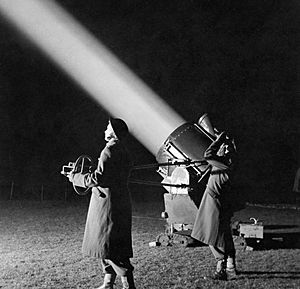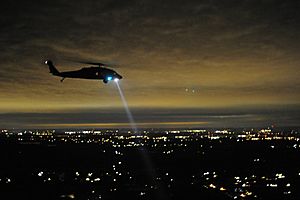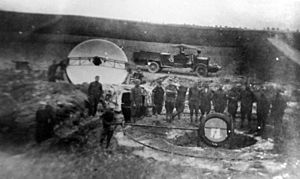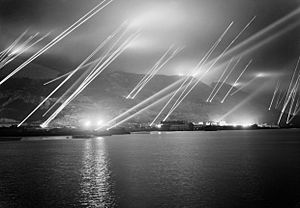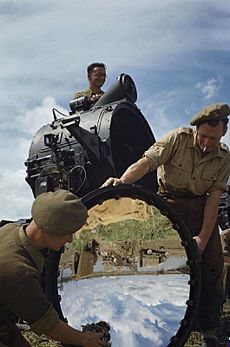Searchlight facts for kids
A searchlight is a very bright light that can shine a powerful beam in one direction. It uses a super strong light, like a special lamp, and a curved mirror to make the light go straight. You can usually turn searchlights around to point them wherever you need.
Contents
How Searchlights Were Used in Wars
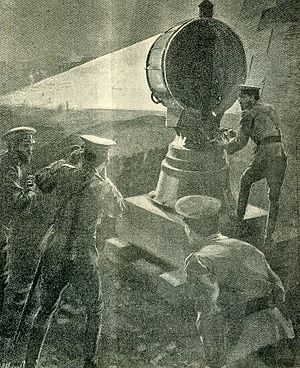
Searchlights were first used in battle during the Siege of Paris in 1870. The British Navy used them in 1882 to stop Egyptian soldiers from using their cannons. Later that year, French and British soldiers landed under the light of searchlights.
By 1907, everyone saw how helpful searchlights were. They could help small torpedo boats attack bigger ships by blinding the enemy gunners. They also helped find enemy ships from far away. Soldiers used them to send signals and guide landing parties. Big warships used searchlights to spot small, fast torpedo boats at night. Many forts along the coast also had searchlights to help fight at night. They were even used in the Russo-Japanese War from 1904 to 1905.
Large navy ships used searchlights from the late 1800s until World War II. They helped track small targets like torpedo boats. They also helped ships fight each other at night. The Japanese Navy was very good at fighting at night. During the War in the Pacific, some night battles were fought using searchlights. One famous battle was the Battle of Savo Sound. Even though searchlights were used, a new invention called radar became much better at finding things. Japan's radar technology was not as good as the US.
Searchlights in World War I
In the First World War, searchlights created "artificial moonlight." They bounced light off the bottom of clouds to help soldiers attack at night. This idea was also used in the Second World War. "Artificial moonlight" meant light from searchlights, while "movement light" was natural moonlight. Searchlights were also very important for defending the UK. They helped spot German Zeppelins that were bombing at night.
Searchlights in World War II
Searchlights were used a lot to defend against nighttime bomber planes in the Second World War. Special devices that listened for sound or used radar helped control the searchlights. The searchlights would track the bombers, showing anti-aircraft guns and night fighter planes where to shoot. They could also blind the bomber crews.
Sometimes, searchlights were used in ground battles. A famous example was during the Battle of the Seelow Heights in April 1945. The Soviet Red Army used 143 searchlights to try and blind the German soldiers. They hoped this would help their attack, which started with a huge artillery bombardment. But morning fog spread the light, making the Soviet soldiers easy to see. The Soviets lost many soldiers and had to delay their attack.
Searchlights from World War II were often 60 inches (152.4 cm) wide. They had a special mirror and a very bright carbon arc lamp. They could shine a beam up to 35 miles (56 km) on a clear night.
Searchlights were also used by planes that fought at night or hunted submarines. The Turbinlite was a strong searchlight put on the front of a British Douglas Boston plane. This plane was changed into a night fighter to shoot down German bombers. The Turbinlite would light up the enemy plane, and other British planes would then shoot it down. This didn't work very well because the bright light made the Turbinlite plane an easy target.
During the Battle of the North Atlantic, British planes like the Vickers Wellington looked for German U-boats (submarines) at night. U-boats would come to the surface to charge their batteries. A big searchlight called a Leigh Light was hung under the plane's wing or body. It would light up the U-boat so the plane could attack it with bombs. The Leigh light worked better than the Turbinlite. But in the end, new radar technology was the best way to find enemies.
Searchlights in Everyday Life
Today, searchlights are used for fun things! You can see them in advertising, at fairs, and at other big public events. They used to be common at movie premieres. The waving searchlight beams are even part of the 20th Century Studios logo.
The most powerful searchlight in the world today shines from the top of the pyramid-shaped Luxor Hotel in Las Vegas. It creates an incredibly bright beam of light. The Tribute in Light is an art project that uses two columns of searchlights. They represent the former Twin Towers of the World Trade Center in New York City. This light display happens every year to remember the September 11 attacks.
Images for kids
-
Searchlights at New Year's Eve 2012 in Bonifacio Global City, Philippines
-
Searchlights demonstrating the height of Tokyo Skytree before its construction in 2007
-
Tribute in Light, representing the World Trade Center twin towers in remembrance of the September 11 attacks


